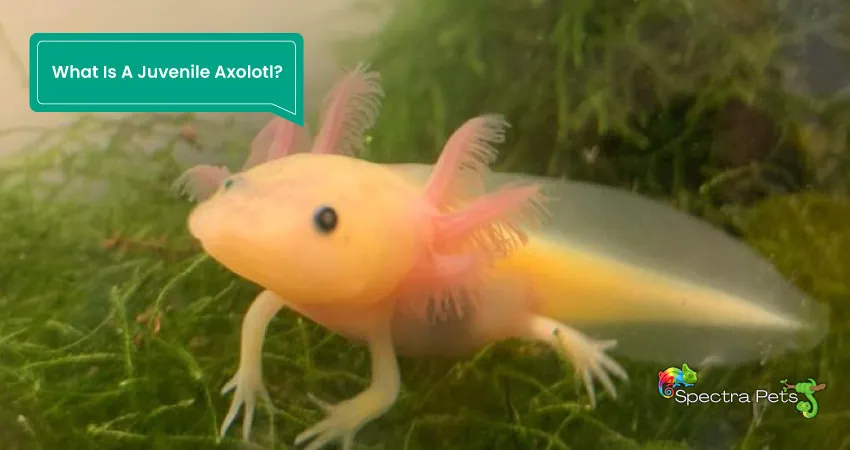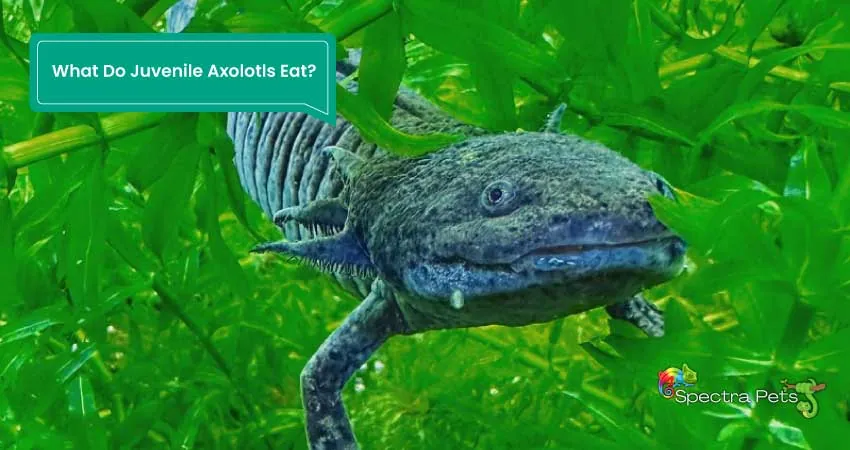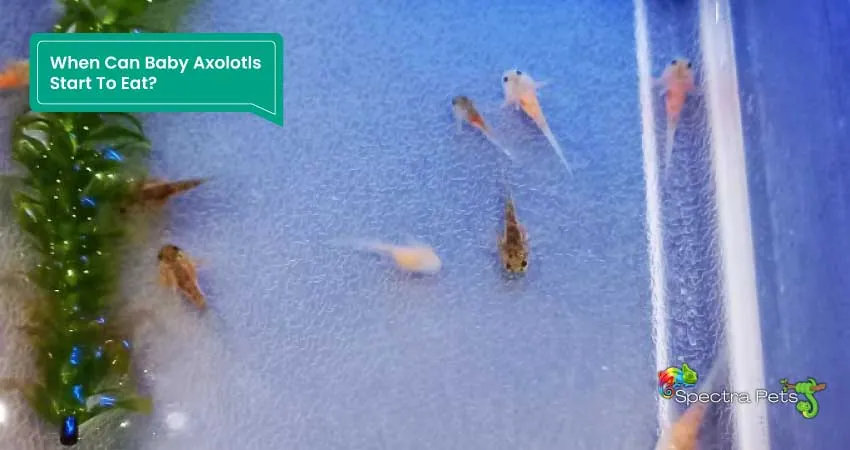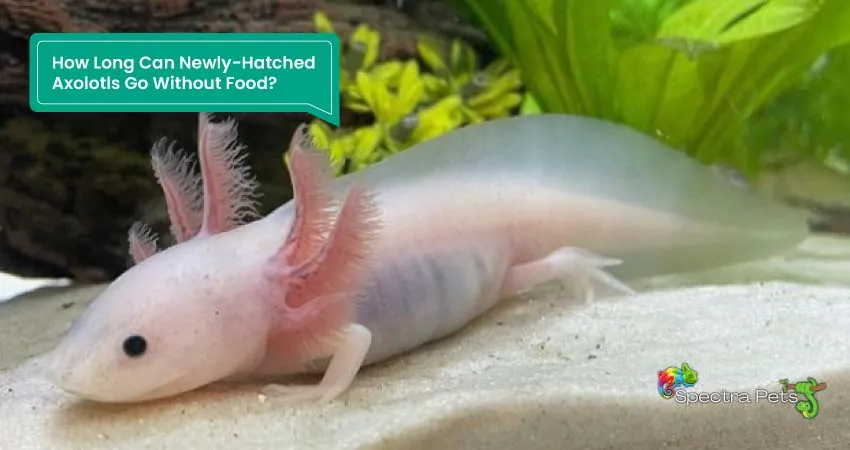Axolotls are perhaps one of the strangest-looking creatures you’ll ever see. But don’t let their appearance fool you; they make great pets. Juvenile axolotls are especially fun to care for since they’re still growing and changing. I can bet they’re fun as hell.
If you have a juvenile axolotl, I’m sure you wonder how to keep them healthy and happy. The best way to do that is by feeding them. But a lot of first-time axolotl owners are unsure of what to feed their new pet. Live daphnia and Brine shrimp are ideal choices for Axolotls, as are blackworms and bloodworms.
Knowing what to feed them is just the start. There are more things you need to know. Hop down below to see what I mean…
What Is A Juvenile Axolotl?

First, let us determine what a juvenile axolotl really is.
Theoretically, you can consider all axolotls juveniles. This is because axolotls never undergo metamorphosis to lose their larval traits. This is also known as neoteny.
Axolotls do, however, get considerably bigger over time, to the point where further growth is impossible. Up until the time of sexual maturity, which occurs about a year after birth, an axolotl can be regarded as a juvenile.
However, individual axolotls have individual growth rates. Some axolotls grow significantly faster than others. Axolotls are considered juveniles when they reach a size of about 15 cm. They reach this size when they are about 4 months old.
What Do Juvenile Axolotls Eat?

Now then, let’s have a look at what you can possibly feed your baby axolotls.
Live Daphnia
Live daphnia is a great option to feed your juvenile axolotls. They are a great source of protein and are easily found in most aquarium shops. You also do not need to spend a fortune on them, and they are equally loved by both juvenile and adult axolotls.
But there is one persistent problem with live daphnia. They are known to harbor a number of illnesses and parasites that can kill any of your axolotls, whether they are young or old.
However, there is a method to prevent this. Live daphnia can be raised and cultivated by you alone. It’s not much work, and there are many inexpensive kits on Amazon to aid you in this.
Brine Shrimp
These crustaceans are another great source of protein for axolotls of any age. You can make them the staple food for your juvenile axolotls, as their nutritional value will ensure the growth and health of your beloved amphibians.
Brine shrimp is also very easy to culture. They have one downside, though. These crustaceans are known to create quite a mess in the aquarium. Therefore, you will need to clean your aquarium more often.
Blackworms
Blackworms are too large to be easily fed to axolotls in their juvenile stage. However, their high nutritional value also makes them excellent choices. That’s why it is recommended to chop the blackworms into tiny, bite-sized pieces. On top of that, blackworms can be fed either fresh or frozen to your juvenile amphibians.
Live blackworms are also quite messy, so remember to clean your tank more often!
Bloodworms
Bloodworms, just like blackworms, are also too big in size for juvenile axolotls. Therefore, they also need to be chopped before feeding.
These worms tend to get stuck in the gills of axolotls. This could potentially lead to a blockage of oxygen intake and consumption. If you see worms stuck in the gills, make sure to remove them very carefully.
Industrial Food Pellets
There are various industrial food pellets available on the market that are specifically designed to meet the nutritional needs of axolotls. They are rich in protein and fat, and come in a small size that fits the tiny mouth of these amphibians.
Axolotls have a strong sense of smell, and they will find the pellets with their odor. Therefore, it is recommended to use pellets that have a strong smell.
Some pellets that I strongly recommend are:
- Soft and sinking pellets
- Fish (particularly salmon) or shrimp pellets
Other Foods
There are various other foods that you can occasionally treat your juvenile axolotls with. These include:
- Earthworms
- Red wigglers
- Ghost shrimp
- Shrimp meat
- Tubifex Worms
- Beef liver
- Beef heart
You should introduce variety to their diet. You can cycle between any of the ones aforementioned every week. This will significantly accelerate your pet’s physical growth.
When Can Baby Axolotls Start To Eat?

Well, newborn axolotls cannot really start eating until they grow to about 12 mm long. They grow to this size in about 1 to 3 days after their birth. During this period, they have some yolk left, which keeps them fed.
After 1–3 days, the babies will have a massive appetite and will munch on any food in a brief period of time.
Axolotl larvae must only be fed live food because it is crucial to their development. They will get by with live food just fine, as they have better eyesight than adults and can detect motion pretty well.
You can also feed them industrial pellets alongside the live food as well. But bear in mind that the food must be sufficiently small to fit in their mouth.
As they reach the juvenile stage, you can give them a variety of foods.
How Should I Feed My Juvenile Axolotl?

Feeding your pet axolotls is an interesting way of interacting with them.
Since you are working with foods that need to be very small, placing them in a small bowl is a good way to feed your pet axolotl.
When feeding worms, you can use tongs. Hold the worms with the tongs and put them in the water to watch your axolotls swim up to the surface and munch on them.
Due to their limited ability to scavenge for food, feeding juvenile axolotls in a large tank can be challenging. It is strongly advised to keep them in a smaller tank when they are younger.
How Often Should I Feed My Juvenile Axolotl?
Compared to adults, juvenile axolotls need to be fed more frequently. The juveniles have a larger appetite and a quicker metabolism rate. They must be fed 2 to 3 times a day, whereas adults only need feeding every 2 to 3 days.
How Much Do You Feed A Baby Axolotl?

Axolotls are opportunistic eaters. They can easily overeat, which can potentially lead to significant health issues and obesity. Therefore, be mindful not to overfeed them.
Underfeeding can be another problem to their health just as well. This could lead to malnutrition, which can result in a decline in growth for the axolotls.
You can put small amounts of food in the aquarium and let them eat for a few minutes. If they finish all the food, then give them another small amount. This way, you can control the quantity of food you’re feeding them.
How Long Can Newly-Hatched Axolotls Go Without Food?

Juvenile axolotls will survive up to 2 weeks without food. This doesn’t mean that you should feed them only once every two weeks. The axolotls will become malnourished and will not grow to their fullest potential.
To Conclude
Now that you know what to feed juvenile axolotls, it’s time to get started. You can purchase most of their foods online or at your local pet store. They’ll have Bloodworms, blackworms and food pellets of various kinds. Buy them and let your axolotl have a go.
These little creatures are so fun and interesting to watch, not to mention easy to care for. With the proper diet, they will grow and thrive in no time. Although I mentioned you can feed them 2–3 times a day, it’s always a good idea to discuss with a vet. Thanks for reading!
